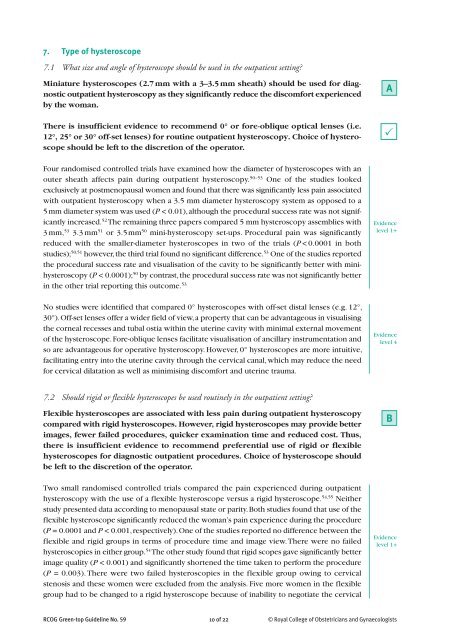Best Practice in Outpatient Hysteroscopy - British Society for ...
Best Practice in Outpatient Hysteroscopy - British Society for ...
Best Practice in Outpatient Hysteroscopy - British Society for ...
Create successful ePaper yourself
Turn your PDF publications into a flip-book with our unique Google optimized e-Paper software.
7. Type of hysteroscope<br />
7.1 What size and angle of hysteroscope should be used <strong>in</strong> the outpatient sett<strong>in</strong>g?<br />
M<strong>in</strong>iature hysteroscopes (2.7 mm with a 3–3.5 mm sheath) should be used <strong>for</strong> diagnostic<br />
outpatient hysteroscopy as they significantly reduce the discom<strong>for</strong>t experienced<br />
by the woman.<br />
There is <strong>in</strong>sufficient evidence to recommend 0° or <strong>for</strong>e-oblique optical lenses (i.e.<br />
12°, 25° or 30° off-set lenses) <strong>for</strong> rout<strong>in</strong>e outpatient hysteroscopy. Choice of hysteroscope<br />
should be left to the discretion of the operator.<br />
Four randomised controlled trials have exam<strong>in</strong>ed how the diameter of hysteroscopes with an<br />
outer sheath affects pa<strong>in</strong> dur<strong>in</strong>g outpatient hysteroscopy. 50–53 One of the studies looked<br />
exclusively at postmenopausal women and found that there was significantly less pa<strong>in</strong> associated<br />
with outpatient hysteroscopy when a 3.5 mm diameter hysteroscopy system as opposed to a<br />
5 mm diameter system was used (P < 0.01),although the procedural success rate was not significantly<br />
<strong>in</strong>creased. 52 The rema<strong>in</strong><strong>in</strong>g three papers compared 5 mm hysteroscopy assemblies with<br />
3 mm, 53 3.3 mm 51 or 3.5mm 50 m<strong>in</strong>i-hysteroscopy set-ups. Procedural pa<strong>in</strong> was significantly<br />
reduced with the smaller-diameter hysteroscopes <strong>in</strong> two of the trials (P < 0.0001 <strong>in</strong> both<br />
studies); 50,51 however,the third trial found no significant difference. 53 One of the studies reported<br />
the procedural success rate and visualisation of the cavity to be significantly better with m<strong>in</strong>ihysteroscopy<br />
(P < 0.0001); 50 by contrast,the procedural success rate was not significantly better<br />
<strong>in</strong> the other trial report<strong>in</strong>g this outcome. 53<br />
No studies were identified that compared 0° hysteroscopes with off-set distal lenses (e.g. 12°,<br />
30°).Off-set lenses offer a wider field of view,a property that can be advantageous <strong>in</strong> visualis<strong>in</strong>g<br />
the corneal recesses and tubal ostia with<strong>in</strong> the uter<strong>in</strong>e cavity with m<strong>in</strong>imal external movement<br />
of the hysteroscope.Fore-oblique lenses facilitate visualisation of ancillary <strong>in</strong>strumentation and<br />
so are advantageous <strong>for</strong> operative hysteroscopy. However, 0° hysteroscopes are more <strong>in</strong>tuitive,<br />
facilitat<strong>in</strong>g entry <strong>in</strong>to the uter<strong>in</strong>e cavity through the cervical canal,which may reduce the need<br />
<strong>for</strong> cervical dilatation as well as m<strong>in</strong>imis<strong>in</strong>g discom<strong>for</strong>t and uter<strong>in</strong>e trauma.<br />
7.2 Should rigid or flexible hysteroscopes be used rout<strong>in</strong>ely <strong>in</strong> the outpatient sett<strong>in</strong>g?<br />
Flexible hysteroscopes are associated with less pa<strong>in</strong> dur<strong>in</strong>g outpatient hysteroscopy<br />
compared with rigid hysteroscopes. However, rigid hysteroscopes may provide better<br />
images, fewer failed procedures, quicker exam<strong>in</strong>ation time and reduced cost. Thus,<br />
there is <strong>in</strong>sufficient evidence to recommend preferential use of rigid or flexible<br />
hysteroscopes <strong>for</strong> diagnostic outpatient procedures. Choice of hysteroscope should<br />
be left to the discretion of the operator.<br />
Two small randomised controlled trials compared the pa<strong>in</strong> experienced dur<strong>in</strong>g outpatient<br />
hysteroscopy with the use of a flexible hysteroscope versus a rigid hysteroscope. 54,55 Neither<br />
study presented data accord<strong>in</strong>g to menopausal state or parity.Both studies found that use of the<br />
flexible hysteroscope significantly reduced the woman’s pa<strong>in</strong> experience dur<strong>in</strong>g the procedure<br />
(P = 0.0001 and P < 0.001,respectively).One of the studies reported no difference between the<br />
flexible and rigid groups <strong>in</strong> terms of procedure time and image view.There were no failed<br />
hysteroscopies <strong>in</strong> either group. 54 The other study found that rigid scopes gave significantly better<br />
image quality (P < 0.001) and significantly shortened the time taken to per<strong>for</strong>m the procedure<br />
(P = 0.003). There were two failed hysteroscopies <strong>in</strong> the flexible group ow<strong>in</strong>g to cervical<br />
stenosis and these women were excluded from the analysis. Five more women <strong>in</strong> the flexible<br />
group had to be changed to a rigid hysteroscope because of <strong>in</strong>ability to negotiate the cervical<br />
Evidence<br />
level 1+<br />
RCOG Green-top Guidel<strong>in</strong>e No. 59 10 of 22 © Royal College of Obstetricians and Gynaecologists<br />
A<br />
<br />
Evidence<br />
level 4<br />
B<br />
Evidence<br />
level 1+



